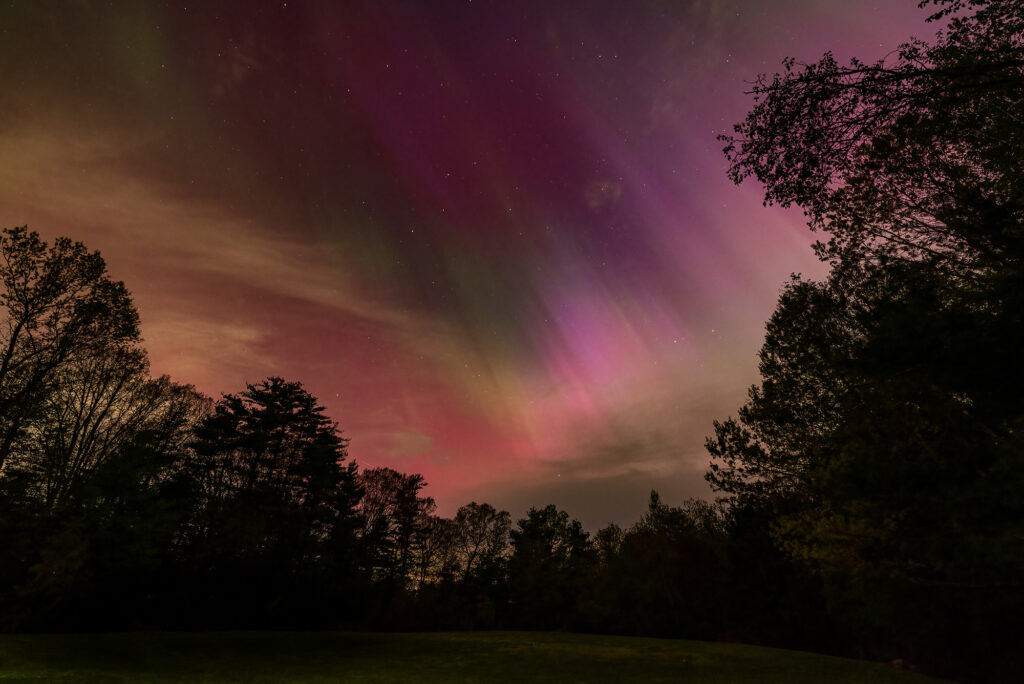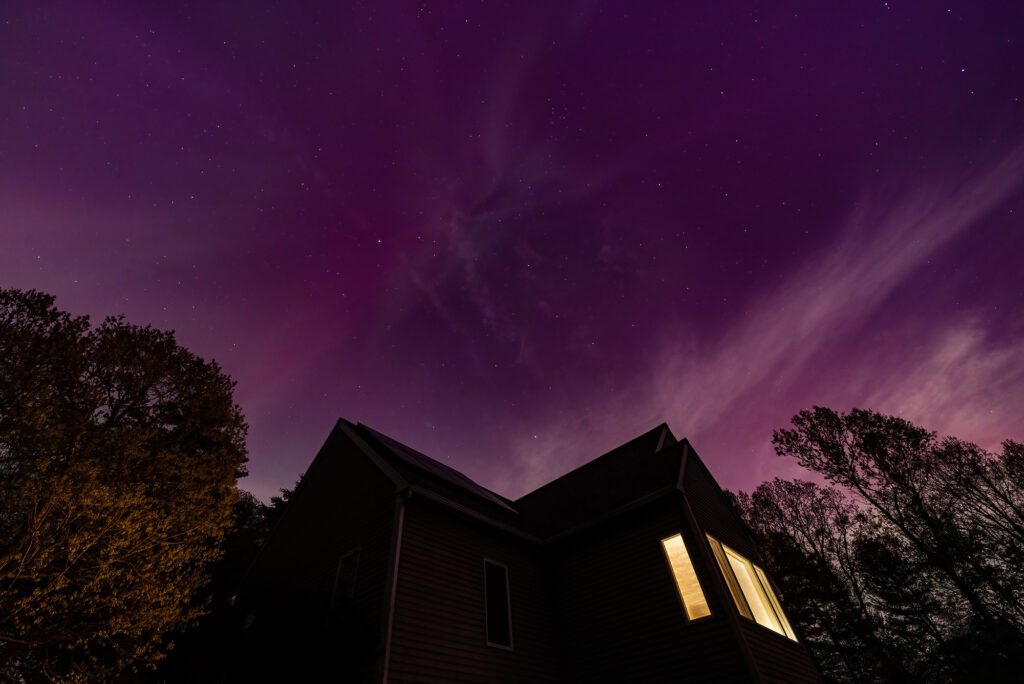
I stood spellbound, watching the images pop up on the back of my camera. A tweak of the settings here, a shift of the tripod there, another *click* — and up popped another wondrous image of this magical, miraculous moment. I stood outside under a dark, slightly cloudy sky, craning my head back and back, squinting my eyes, trying to see this extraordinary natural event with my own eyes. What I had first taken to be hazy clouds turned out to be the actual aurora, a faint sheen spread over the skies that was easy to miss, especially when I first stepped out from the house, night-blind in the darkness. I had brought my camera and tripod but really wasn’t expecting much. I set up in the backyard, swatted away a few persistent mosquitoes, and clicked the shutter. There was a delay as the shutter opened for some seconds and then closed. And then the image displayed on the back screen – and my jaw dropped. I literally gasped out loud. There was an image of the aurora, THE AURORA BOREALIS, right there on my camera, right there over my head, in all its sublime glory. I was astounded and awed.

The (Inertia) Struggle is Real
To think I almost missed the whole thing entirely. Somehow, I had missed all the buildup; I had heard whispers of a larger magnetic storm and the possibility of an aurora. But I was thinking this aurora thing would be further north and those of us in Massachusetts and similar or lower latitudes would miss it. I never imagined we might be able to see it in Mass. It wasn’t until my husband Tom told me about it that afternoon that I realized there actually was a chance we could see it. I decided I would try to photograph this unusual event.
However, the evening seemed cloudy and the couch was comfy after a busy and stressful week. I sighed and sighed again as I thought about grabbing my gear and going outside. I thought of all the reasons why I would probably not see the Northern Lights, the clouds, the light pollution, the trees. I sighed again. And then I pushed myself off that black hole of a couch and got my equipment. I’ve recently become enamored with nightscape photography, photographing the stars and Milky Way. I wanted to try out some of what I had learned, especially since it was difficult to photograph the Milky Way where I live, between the light pollution and tree-covered hills around our neighborhood. If I really want to do nightscape photography, here was my chance to practice. And I knew I would regret it if I didn’t try. So out I stepped into the dark, my camera on my tripod over my shoulder.
Moral of the story: what really got me moving was the avoidance of regret — I didn’t want to regret missing this amazing, possibly once-in-a-lifetime event. That is really not that inspiring but it worked…

Aurora Awe
And I am so glad I did! As the images flickered into existence on my camera’s back screen, each one different, a unique combination of ethereal colors and patterns, I was mesmerized, struck still with awe. Truly, an exploding, engulfing, consuming awe. I stood looking at those photos and then looking at the sky and I felt so small. And yet, connected to something larger than myself. It was a transcendent experience and I am so grateful to have been there in that moment to experience it.
And thanks to Tom for making sure I knew about the aurora and helping me find the motivation to get out there and experience it!



Real Life and Juggling Priorities
You may have noticed a little gap between this post and my last one in March (ahem, three months). Well, life got busy and as well-intentioned as I was about posting regularly to my new blog, yeah, well, life got busy. Please forgive the gap! I hope to post more regularly as time goes on – but I reserve the right to cut myself some slack when I need it. We can all use some grace, I think.


Let’s connect!
Please share your experience with the May 2024 aurora. Did you see it where you are? What was it like? Were you able to photograph it? Have you seen an aurora before? Do comment below, I would love to hear from you! And feel free to share photos on the From Flora to Fauna Facebook page, I’d love to see your photos!

Fun Facts:
- Auroras seen in the northern hemisphere are called aurora borealis, or Northern Lights. Those seen in the southern hemisphere are called aurora australis, or Southern Lights.
- Auroras are caused by particles from the solar wind colliding with Earth’s magnetosphere, exciting atoms in the atmosphere, which then emit light.
- The different colors of auroras are produced by different gases and altitudes. Oxygen produces green and red lights, while nitrogen produces blue and purple lights. Green is the most common color of auroras.
- Auroras are commonly seen near the poles, due to the shape of the Earth’s magnetic field. The inestimable Neil deGrasse Tyson explains why in a YouTube short: https://youtube.com/shorts/zZMxxQP9Ha0?si=OlzpnLeiF8DO0tTT. But with strong solar storms, auroras can be seen in lower latitudes like the recent one in May 2024.
- Astronauts can see auroras from space.
- Auroras are not unique to Earth, they occur on other planets with strong magnetic fields and the right atmospheric composition.

I LOVE this blog, Seana! Not only is it beautifully written, but it is also full of gorgeous photos!
Love you, friend. So proud of you!
Awww, thank you, Lori! That is so kind, I really appreciate your comment and support. In fact, you have made the FIRST COMMENT EVER. That’s extra special, thank you, my friend!!